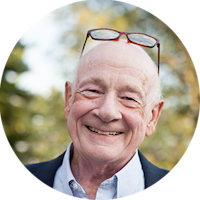I have absolutely no fear of death. From my near-death research and my personal experiences, death is, in my judgment, simply a transition into another kind of reality.
I have absolutely no fear of death. From my near-death research and my personal experiences, death is, in my judgment, simply a transition into another kind of reality.
Raymond A. Moody Jr.

Life After Life
Theme: Life Beyond Death
I have absolutely no fear of death. From my near-death research and my personal experiences, death is, in my judgment, simply a transition into another kind of reality.
Raymond A. Moody Jr., born on June 30, 1944, in Porterdale, Georgia, is a pioneering figure in the study of near-death experiences (NDEs). Raised in a family with an agnostic surgeon as a father, Moody’s early exposure to questions about life and death would later shape his career. He pursued higher education at the University of Virginia, where he earned a BA, MA, and PhD in philosophy by 1969. His academic journey continued with a PhD in psychology from the University of West Georgia and an MD from the Medical College of Georgia in 1976, marking him as both a philosopher and a medical doctor.
Moody's groundbreaking work on NDEs began in the 1970s, when he coined the term “near-death experience” in his 1975 book Life After Life. The book was an international success, selling over 13 million copies and bringing the concept of NDEs into mainstream awareness. Through interviews and case studies, Moody identified common elements in these experiences, such as feelings of peace, seeing a bright light, and out-of-body experiences. His work revolutionized how both medical professionals and the public understand death and the possibility of life beyond it. In addition to his writing, Moody served as a forensic psychiatrist and was appointed chair of Consciousness Studies at the University of Nevada, Las Vegas in 1998.
Raymond Moody’s influence extends beyond academia and literature. His research has shaped discussions in psychology, medicine, and spirituality, offering a framework for exploring the mysteries of death and consciousness. Over the decades, he has been recognized with awards like the World Humanitarian Award in 1988 and continues to be a prominent voice in NDE studies. Through his continued writing and public speaking, Moody remains an authoritative figure in the field of consciousness and near-death research, fostering a deeper understanding of the human experience of death.
Life After Life
Moody, Raymond A. Life After Life: The Investigation of a Phenomenon—Survival of Bodily Death. HarperOne, 2016.

Raymond A. Moody Jr.
Theme: Life Beyond Death

About This Raymond Moody Quotation [Commentary]
Raymond Moody’s statement, “I have absolutely no fear of death. From my near-death research and my personal experiences, death is, in my judgment, simply a transition into another kind of reality,” reflects a steady confidence shaped by decades of inquiry into human consciousness. His use of “absolutely no fear” signals not just a personal belief, but a grounded conclusion drawn from both study and lived experience. The pairing of “near-death research” with “personal experiences” gives weight to his view, blending investigative rigor with firsthand insight. When he calls death “simply a transition,” he points to a shift—not an end—into “another kind of reality.”
This clarity is informed by thousands of accounts he has studied, many describing peace, light, and love on the other side of clinical death. In Life After Life, Raymond Moody identifies recurring elements such as feelings of well-being, encounters with loved ones, and entry into realms unlike physical life. His expanded reflections further suggest that “the process of knowledge does not stop when we die,” and that individuals continue to grow in a “state of consciousness… so extraordinarily different… that the language we have is not yet adequate to describe” it. His focus remains on listening to others and staying close to what is being revealed through their experience.
In addressing life beyond death, Raymond Moody does not speculate loosely. He states plainly that “death is, in my judgment, simply a transition.” This phrase—both careful and direct—indicates not a symbolic notion but a conclusion grounded in years of careful observation. The idea of “another kind of reality” offers space for mystery without leaning on fantasy. In recognizing this continuity, he invites us to reconsider death itself—not as a feared endpoint but as part of a larger unfolding of consciousness that belongs to all.
Commentary From Nora Spurgin’s Insights Into the Afterlife
What is a “near-death experience”?
With advancements in modern technology, the number of people who have been revived from clinical death has significantly increased. Many of these individuals report remarkably similar experiences, now widely known as near-death experiences (NDEs). In the past, people may have hesitated to share these experiences due to fear of ridicule, but thousands today openly recount their NDEs, which has transformed this area of research from speculation into documented observation.
Near-death experiences gained global attention when Dr. Raymond Moody’s book Life After Life became a bestseller. Based on his extensive research, Dr. Moody identified key elements that frequently appear in these accounts. These include: the feeling of a continuous sense of identity after death, observing the physical body from outside it, and encountering sensations of peace, love, and lightness. Other common elements involve traveling through a dark tunnel toward a bright light, meeting deceased loved ones, and encountering spiritual beings or religious figures.
Many individuals also report a life review, a vivid panoramic replay of their earthly life. While these experiences share common features, there is often a point where individuals are given the choice to return to their physical bodies. Those who return typically describe an enhanced appreciation for life, a renewed sense of purpose, and a lack of fear regarding death.
Is going to the spirit world automatic?
Yes, entering the spirit world is a natural and inevitable process. Every human being is created with an eternal spirit, and life in the spirit world is simply the next step after life on earth, just as life on earth follows life in the womb.
—Spurgin, Nora M. Insights into the Afterlife. Holy Spirit Association for the Unification of World Christianity, 1998, pp. 5–6.
Resources
Related Quotes
Copyright © 2017 – 2025 LuminaryQuotes.com About Us